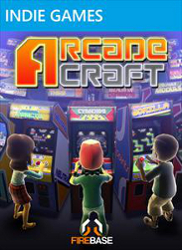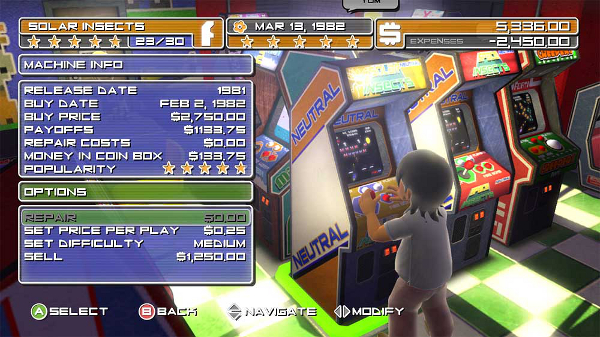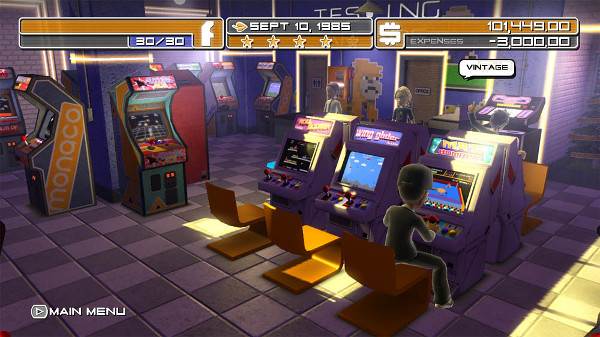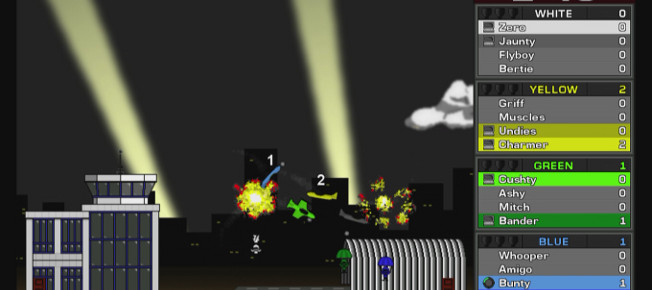 I love a good simulation or strategy game. I think it appeals to the engineer in me, because I enjoy taking something unknown and figuring out how it works. Playing a game in one of these genres – though they often meld together – almost always turns out the same. It’s about maximizing success through gaining an intimate knowledge of the game’s complex systems and inner workings. Arcadecraft, a strategy/simulation game for the Xbox, is no different. But while this Firebase Industries title plays on a subject matter near and dear to many-a-gamer’s heart, it also suffers from a few design issues that derail the overall enjoyment of the experience.
I love a good simulation or strategy game. I think it appeals to the engineer in me, because I enjoy taking something unknown and figuring out how it works. Playing a game in one of these genres – though they often meld together – almost always turns out the same. It’s about maximizing success through gaining an intimate knowledge of the game’s complex systems and inner workings. Arcadecraft, a strategy/simulation game for the Xbox, is no different. But while this Firebase Industries title plays on a subject matter near and dear to many-a-gamer’s heart, it also suffers from a few design issues that derail the overall enjoyment of the experience.
Despite it’s title, Arcadecraft is not yet another Minecraft clone available through the Xbox Live Indies Games market. Instead, it’s a game that puts players in the role of an arcade manager in that scene’s heyday of the early 1980s. Arcadecraft plays on actual history by including events like the video game crash of 1983 and ending with a nod to the release of the NES in 1985. Through it all, it’s up to the player to ensure that their arcade is remaining popular with the crowds and racking in enough money to pay the bills.
Shown from an isometric perspective, the empty arcade is the player’s canvas for creating a gaming hotspot. As the ever-running calendar moves from month to month, game publishers release new arcade cabinets available for purchase by the player. These cabinets vary in initial cost, genre, control method, number of floor spaces occupied, power consumption, and a few other characteristics. Once purchased and placed on the floor, each cabinet will begin drawing in money based on a few factors including the arcade’s current popularity rate and the popularity of the individual machine. The newer a machine is, the quicker it makes money. That money must be repeatedly collected from the machine by the player, otherwise the game stops raking in coins.
I give credit to the developers for trying to add strategic depth through individual game cabinet settings. However, I found that the game suffers from a pacing problem that interferes with the use of that level of customization. The early portion of Arcadecraft speeds by too quickly to really get a grasp of how or when the settings will affect that cabinet’s money-making ability. Early on there’s not much incentive to fiddle with the defaults because of the risk of failure, and later in the game there’s simply too much money-collecting taking place to do anything else. It was only once I hit the final year of the simulation – when no new arcade cabinets are available for purchase – that I really started toying around. There are lessons to be learned from the first full play-through of the game, but it’s doubtful most players are going to go back and repeat the exact same sequence of events using that newly-gained knowledge. I think if the developers had decided to include a controllable speed setting, just like in Smooth Operators: Call Center Chaos, it would give players a chance to run their arcade at a pace that allows for experimentation.
One of the best aspects of the game has to be the homage to the gaming industry of three decades ago. It’s an interesting look back at the evolution of technology as newer games offer varying cabinet styles and control methods. There’s also a bit of a nostalgia factor as a number of the games in Arcadecraft are parodies of classics like Donkey Kong and Space Invaders. Some of the game publishers even release sequels to their titles ala Pac Man and Ms. Pac Man. If the player manages to hold onto the original and can seat the sequel(s) next to it, each machine gets a popularity boost.
There are a number of other interesting strategical decisions that the player must make during the lifespan of the arcade. Periodically a pro-gamer will stop by and want to try one of the most popular machines. If he manages to beat the high score, a popularity boost will temporarily be placed on that machine. The trade-off is that while he’s hogging the machine it’s not earning any money. From time to time, a vendor will stop by and offer to buy one of the player’s classic gaming arcade cabinets for a high ticket price. However, to keep a machine around long enough for it qualify as a classic generally means its old and far less popular (read: cost-ineffective) than the latest and greatest cabinets.
As with many simulation games, Arcadecraft suffers in its endgame. Once the player has reached the two-year mark and paid off their debt, most of the challenge is gone. Truth be told, I failed to pay off that debt during my first go-round, but that experience was an education in the keys to winning: start slow and continue to replace old, unpopular machines as soon as you can buy new ones. Once the player figures that lesson out, the challenge changes from mental strategy to menial labor as he/she has to repeatedly run around in a frenzy emptying coin boxes. It becomes tedious very fast, and the ability to hire an automated helper does little to relieve the effort of maintaining a large number of cabinets. At this point, the goal becomes simply trying to collect as much money as possible before the simulation ends. Unfortunately the lather-rinse-repeat process happens earlier in this title than some of the similar games I’ve played on XBLIG. Ultimately I would have liked to have seen a slower-paced game with more to do during that time than collect money and fix broken machines.
Arcadecraft‘s premise and early execution show so much promise that I was doubly disappointed when I became bored by the end. One or two design choices made differently would have been the difference between this being a decent game and a great one. It’s obvious that the developers put a lot of work into the presentation. I fear, though, that the 240 Microsoft Point price tag in a typically 80-Point market may keep even the most curious of players away. I think it’s still worth a look for those who enjoy simulation/strategy games and those who can still remember the golden age of arcades.
Overall Rating: 




What does this score mean?
This game was reviewed using a copy provided by the developer for that purpose.
© 2013, The Indie Mine. All rights reserved.






